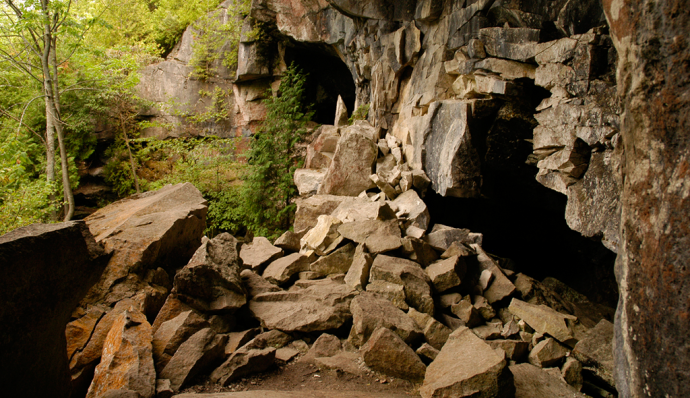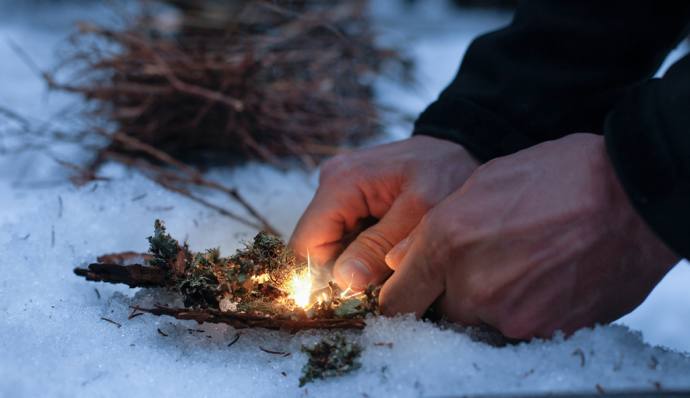I love being outside. I love exploring the wilderness, discovering new-to-me natural wonders and unexplored trails. But through all of this beauty and exploration, it’s important to remember that the unexpected can happen to you, too. Learning to survive in the wilderness is a critical skill if you plan on spending any amount of time outdoors.
Wilderness survival guide
 Here is the thing: with fancy gear and new advances in outdoor technology, it can be easy to forget that the wilderness is an environment fraught with peril. It’s not like what you see on television; the wilderness is no joke. I don’t say this to intimidate or scare anyone. Rather, I think it is important for outdoor enthusiasts to understand what they are embarking upon. Do you know how to build a shelter? Could you light a fire without any matches? Could you figure out how to survive? For most people, the answer is no. But instead of stressing about what you don’t already know, take action to educate yourself. Below is a basic wilderness survival guide. Learn the basics so that you are always prepared in an emergency situation. Trust me; this will make your backcountry experiences a lot more fun!
Here is the thing: with fancy gear and new advances in outdoor technology, it can be easy to forget that the wilderness is an environment fraught with peril. It’s not like what you see on television; the wilderness is no joke. I don’t say this to intimidate or scare anyone. Rather, I think it is important for outdoor enthusiasts to understand what they are embarking upon. Do you know how to build a shelter? Could you light a fire without any matches? Could you figure out how to survive? For most people, the answer is no. But instead of stressing about what you don’t already know, take action to educate yourself. Below is a basic wilderness survival guide. Learn the basics so that you are always prepared in an emergency situation. Trust me; this will make your backcountry experiences a lot more fun!
Essential skills
In order to survive a night in the wilderness, you will need to have a few skills in your tool kit. These essential survival skills are the basic requirements of a comfortable and safe night in the wild.
How to build a shelter
Learning how to build a shelter is extremely important to your survival. Not only can this makeshift shelter become your home away from home, but it will also protect you from wind, rain, snow or even sun. If you build it properly, your emergency shelter can also keep you warm since you can contain your fire within it. In some situations, your need for shelter may take precedence over your body’s need for food and, potentially, even water. If your unplanned overnight stay takes place during extremely cold temperatures, you will want to prioritize your shelter in order to protect yourself from hypothermic conditions. In harsh conditions (like a blizzard), the general rule is that you have three hours to survive without a shelter. First, consider the location of your shelter. Your site selection must include enough of the material needed to build the shelter. It’s also a good idea if the site is located near a water source. Of course, your shelter must also protect you from the wind. I would also suggest evaluating the potential problems that could arise due to the surrounding environment. For example, building your shelter in a low flatland area could lead to flooding during heavy rainstorms. Avoid setting up shop below rocky hillsides prone to rockslides. Next, consider the size of your shelter. It must be big enough for you to lay down inside so you can rest and recover. That said, you don’t want to build an extra large shelter. The bigger the shelter, the more body heat and fire it takes to warm the inside. In cold conditions, it is much easier to warm up the interior of a smaller shelter. There are a few types of shelters that make for good options.
- Natural shelters: Natural landmarks such as caves or overhanging cliffs are great survival shelters. Keep in mind that a cave may have existing tenants in the form of wildlife, so be on the alert. If you do opt for a cave, build your fire at the entrance to discourage animals from entering while you are inside.
- Lean-to: A lean-to shelter is one of the most popular options due to its simplistic construction; you can build a lean-to out of almost anything. Tree branches or rope construct the frame while a tarp, poncho, bark, or tree boughs provide protection from the elements.
- Tree wells: If you are stranded in a heavily wooded forest, a large tree well makes for a great shelter. Simply enlarge the natural well to accommodate your body and use tree boughs or a tarp to construct a roof.
- Snow cave: In wintry conditions, a snow cave is an effective shelter. Find a large snow drift (at least five feet deep if possible) and burrow a tunnel. At the end of a tunnel, create a large chamber big enough to fit your party. Not only will this cave protect you from the elements, but the snow’s insulating properties will keep you warm. Remember to poke a few holes in the roof for ventilation. If the conditions aren’t right for a cave, consider a snow trench. Dig out a trench large enough for your body and cover the top with a tarp, poncho or any debris you can find.
Above all, remember the following acronym when building your emergency wilderness shelter: BLISS. B - Blend in with the surroundings L – Low silhouette I – Irregular shape S – Small S – Secluded location
How to find water & food
Food and especially water are critical concerns when surviving in the wild. While uncomfortable, humans can go up to three weeks without food but the rule of thumb is that we can only survive three days without water. As such, finding water is your first priority. Ideally, you are looking for two or three cups of water per day to keep your systems functioning smoothly. In the summer, this may not be difficult. Running water like streams or waterfalls make for great sources. In many quiet areas, the water may be safe to drink on its own. However, stagnant bodies of water like ponds or lakes likely carry diseases that will make you incredibly sick. When in doubt, purify the water. You can do this by boiling it for three minutes, treating it with Iodine tablets, or pumping it through a water filter. If you can’t find any water sources, get creative. If you find a damp or muddy area, dig into the ground and create a hole. There is a good chance the hole will begin to fill with water. Of course, you will want to treat this water but it will serve its purpose in hydrating you. Collecting rainwater is a great option, as is the collection of dew drops that gather on plants. In the winter months, finding water may be easier. Look underneath ice for small streams of running water. When possible, melt ice rather than snow as this is more fuel-efficient. It is also a good idea to avoid eating snow. While that may seem counterintuitive, your body puts a lot of effort into heating and melting the snow. Since there is minimal hydration in return, eating snow actually dehydrates your body even more. Finding food may be trickier. It is a good practice to try to forage or find local food sources before digging into your emergency rations. As a general rule, you will be looking for food in the form of wildlife or plants. Snares, traps and nets will help you snag an animal for food. Study your surrounding environment and identify the most trafficked game trails. Not only are these the best locations for a trap, but they frequently lead to water holes used by the animals. Foraging may sound easier than snagging an animal but be aware: many plants are poisonous, so it is imperative that you are confident in your plant selection before cooking up a leafy green stew. While there is no one rule that applies to the entire forest, there are a few guidelines that will generally help you make your selections:
- Avoid red or white berries
- Boiling removes some poisons (but not all)
- Watch what the animals eat. There is a good chance that you can eat the same things.
- Avoid mushrooms. Many mushrooms are edible, but your identification must be precise to avoid eating poisonous varieties.
I’d suggest acquiring a copy of Identifying and Harvesting Edible and Medicinal Plants in Wild by Steve Brill and Evelyn Dean. This guidebook shows readers how to find and harvest over 500 different plants for consumption and medicinal purposes. Using a guidebook such as this, you are sure to learn about a few native plants in your area that are safe to eat.
How to start a fire
 I’d argue that building a fire is the most important task in wilderness survival. Not only will this fire keep you warm in cold environments, but it will also allow you to boil water for purification and help stave off wildlife. First, find a safe location for your fire. If possible, opt for a sandy or rocky area to avoid causing any type of forest fire. After selecting your site, evaluate your options. Waterproof matches are your best bet and hopefully you are carrying some with you. Many brands sell waterproof matches now and I’d advise you to always carry some. However, waterproof matches do cost more than regular matches, so it is possible to waterproof your own regular matches. There are two ways to do this: wax or nail polish. (Be sure to start with wooden matches.) Both wax and nail polish will keep moisture from ruining the strike point on a match. If you prefer wax, light a candle at home and wait until the wax turns to liquid around the wick. Once it does, dip the head of the match into that liquid. Be sure it adequately covers the head of the match, but try to keep the wax from getting too thick. A thick layer will be trickier to strike off once you need to use the match. Nail polish is a more common option, largely since it is easier to do. Grab any bottle of polish (you can choose the color!) and dip the match inside the bottle so that the paint covers the match head and a little bit of the wood beneath it. Again, make sure there are no gaps in coverage. In addition to waterproof matches, it is always a good idea to have a backup lighter or two. They take up minimal space and provide you with a variety of options for making a fire. In addition to matches and a lighter, flint and steel is one of the most classic techniques used to start a fire. This method is very reliable and can be used in all conditions, even when wet. Simply strike the steel (or a pocket knife, for example) against the flint and aim the sparks into your prepared bed of tinder. Once you’ve established how you’re creating the fire, you need to build a dry bed of timber that is easily flammable. For many environments, this can be as simple as collecting dry bark, grass or kindling. However, it is always a good idea to carry prepared tinder with you in case you find yourself in a rainstorm or somewhere where all of the natural tinder is soaked. Dryer lint and a Vaseline-soaked cotton ball are popular options. Just be sure to store them in a film canister or somewhere else protected from exterior moisture. Finally, if you are building a fire in or near your shelter, don’t forget about ventilation. You want that fire to keep you warm, but you don’t want to suffocate yourself!
I’d argue that building a fire is the most important task in wilderness survival. Not only will this fire keep you warm in cold environments, but it will also allow you to boil water for purification and help stave off wildlife. First, find a safe location for your fire. If possible, opt for a sandy or rocky area to avoid causing any type of forest fire. After selecting your site, evaluate your options. Waterproof matches are your best bet and hopefully you are carrying some with you. Many brands sell waterproof matches now and I’d advise you to always carry some. However, waterproof matches do cost more than regular matches, so it is possible to waterproof your own regular matches. There are two ways to do this: wax or nail polish. (Be sure to start with wooden matches.) Both wax and nail polish will keep moisture from ruining the strike point on a match. If you prefer wax, light a candle at home and wait until the wax turns to liquid around the wick. Once it does, dip the head of the match into that liquid. Be sure it adequately covers the head of the match, but try to keep the wax from getting too thick. A thick layer will be trickier to strike off once you need to use the match. Nail polish is a more common option, largely since it is easier to do. Grab any bottle of polish (you can choose the color!) and dip the match inside the bottle so that the paint covers the match head and a little bit of the wood beneath it. Again, make sure there are no gaps in coverage. In addition to waterproof matches, it is always a good idea to have a backup lighter or two. They take up minimal space and provide you with a variety of options for making a fire. In addition to matches and a lighter, flint and steel is one of the most classic techniques used to start a fire. This method is very reliable and can be used in all conditions, even when wet. Simply strike the steel (or a pocket knife, for example) against the flint and aim the sparks into your prepared bed of tinder. Once you’ve established how you’re creating the fire, you need to build a dry bed of timber that is easily flammable. For many environments, this can be as simple as collecting dry bark, grass or kindling. However, it is always a good idea to carry prepared tinder with you in case you find yourself in a rainstorm or somewhere where all of the natural tinder is soaked. Dryer lint and a Vaseline-soaked cotton ball are popular options. Just be sure to store them in a film canister or somewhere else protected from exterior moisture. Finally, if you are building a fire in or near your shelter, don’t forget about ventilation. You want that fire to keep you warm, but you don’t want to suffocate yourself!
Dealing with wildlife
In general, there isn’t a lot you can do to control wild animals. That said, if you find yourself living in the wild, there are a few general guidelines to follow to help keep yourself safe when encountering animals.
- Don’t panic. Stay calm so that the animal does not interpret your panic attack as an offensive maneuver. Animals usually only attack when they feel threatened.
- Allow for an escape route. More often than not, an animal is going to want to hightail it away from you as quickly as possible. Give the animal room to escape and it will likely choose that option.
- Slowly and calmly back away. Keep your cool and back away from the animal while keeping your eyes on it at all times. The more distance between you and the creature, the safer it will likely feel, which minimizes its threat to you.
Gear checklist
Before heading out into the wilderness, use this checklist to ensure you have everything you need. Not only will you be comfortable, but you can be confident in knowing you have the essentials to ensure your safety should the worst actually happen.
- Layers. Be sure to bring a base layer, an insulating layer, and an exterior shell to protect you from the elements.
- Backpack
- Topographic map
- Compass
- Learn how to choose a compass
- Learn how to use a compass
- A flashlight or headlamp with extra batteries
- A pocket knife or multitool
- Waterproof matches, a lighter and/or flint
- A bright tarp or poncho that can be used to build your shelter as well as to signal in an emergency
- Emergency tinder
- First aid kit
- Sun protection: sunglasses, a hat, sunscreen, etc.
- Extra food and water
- Extra clothing
- Cordage
Wilderness survival looks simple thanks to popular TV shows. But in reality, surviving in the wild is not so easy. Learning survival basics and being prepared with the right essentials can help you make it through an unplanned night in the woods.





